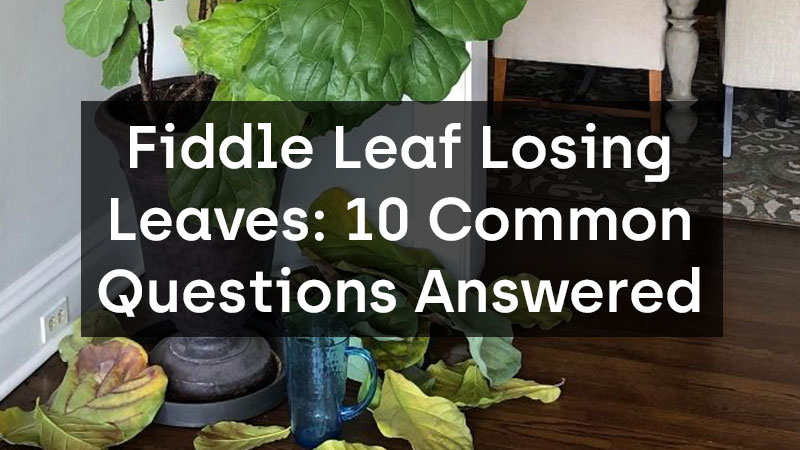Table of Contents
- Why Are My Fiddle Leaf Fig’s Leaves Falling Off?
- Can I Save the Leaves That Have Fallen Off?
- How Do I Propagate Fiddle Leaf Figs from Cuttings?
- Can Pruning Help Prevent Leaf Loss?
- How Can I Prevent Pests on My Fiddle Leaf Fig?
- When Should I Repot My Fiddle Leaf Fig?
- Can I Grow a Fiddle Leaf Fig Outdoors?
- Should I Fertilize My Fiddle Leaf Fig During the Winter?
- Are Brown Edges on the Leaves a Sign of Trouble?
- Can a Fiddle Leaf Fig Recover from Severe Leaf Loss?
1. Why Are My Fiddle Leaf Fig’s Leaves Falling Off?
Fiddle leaf figs can lose leaves due to several factors. Here’s a detailed explanation of the common reasons and how to address them:
Overwatering:
- Overwatering is a leading cause of leaf drop. Ensure that the plant’s pot has proper drainage, and only water when the top inch of soil is dry.
Underwatering:
- Failing to provide enough water can also cause leaf loss. Make sure to water consistently and avoid letting the soil dry out completely.
Poor Lighting:
- Inadequate or excessive light can stress the plant. Place it in bright, indirect light to maintain healthy foliage.
Pests:
- Common pests like spider mites and mealybugs can harm your fiddle leaf fig. Regularly inspect the plant and treat any infestations promptly.
Root Rot:
- Root rot can occur if the plant is in excessively damp conditions. Repot in well-draining soil if root rot is suspected.
Temperature Fluctuations:
- Fiddle leaf figs prefer stable temperatures. Avoid exposing them to cold drafts or sudden temperature changes.
Nutrient Deficiency:
- Fertilize your plant with a balanced liquid fertilizer during the growing season to prevent nutrient deficiencies.
Humidity:
- Insufficient humidity can cause leaf browning and drop. Consider misting or using a humidity tray to increase moisture levels.
Repotting Stress:
- Repotting can stress the plant. Ensure you do it during the growing season and provide proper care post-repotting.
Seasonal Leaf Shedding:
- Fiddle leaf figs may naturally shed some older leaves during seasonal changes. This is typically not a cause for concern.
By understanding and addressing these factors, you can help your fiddle leaf fig maintain its lush greenery and minimize leaf loss.
2. Can I Save the Leaves That Have Fallen Off?
Fiddle leaf fig leaves that have fallen off cannot be reattached to the plant. However, you can propagate new plants from healthy leaves or stem cuttings.
3. How Do I Propagate Fiddle Leaf Figs from Cuttings?
To propagate fiddle leaf figs from cuttings, follow these steps:
-
- Take a 6-8 inch cutting with at least one node (where a leaf is attached).
- Allow the cutting to callus for a day or two.
- Plant the cutting in a well-draining soil mix.
- Provide indirect light and maintain humidity by covering the cutting with a plastic bag or using a humidity dome.
- Keep the soil consistently moist but not waterlogged.
- Roots should develop within a few weeks, and you can transplant the new plant into a larger pot.
4. Can Pruning Help Prevent Leaf Loss?
Pruning can help your fiddle leaf fig maintain a desirable shape and encourage new growth. Remove any damaged or yellowing leaves to promote overall plant health. However, avoid excessive pruning, which can stress the plant.
5. How Can I Prevent Pests on My Fiddle Leaf Fig?
Preventing pests on your fiddle leaf fig involves regular inspection and care. Here are some tips:
- Isolate new plants for a few weeks to prevent introducing pests.
- Keep the plant clean by wiping leaves with a damp cloth.
- Use neem oil or insecticidal soap to treat and prevent common pests.
6. When Should I Repot My Fiddle Leaf Fig?
Repot your fiddle leaf fig when it has outgrown its current pot or when you notice signs of root rot. It’s best to do this during the growing season (spring or early summer). Select a slightly larger pot with proper drainage and use a well-draining potting mix.
7. Can I Grow a Fiddle Leaf Fig Outdoors?
Fiddle leaf figs are tropical plants and are best suited for indoor conditions. However, they can thrive outdoors in warm, tropical climates with filtered sunlight and consistent humidity.
8. Should I Fertilize My Fiddle Leaf Fig During the Winter?
During the winter, fiddle leaf figs experience slower growth, so you can reduce the frequency of fertilization. Instead of weekly feedings, switch to monthly or bi-monthly fertilization during the dormant season.
9. Are Brown Edges on the Leaves a Sign of Trouble?
Brown edges on fiddle leaf fig leaves can be caused by various factors, including low humidity, underwatering, or nutrient deficiencies. Address these issues to prevent further browning.
10. Can a Fiddle Leaf Fig Recover from Severe Leaf Loss?
Fiddle leaf figs can recover from severe leaf loss with proper care. Focus on providing the right environment, consistent watering, and adequate nutrients to encourage new growth.







0 Comments